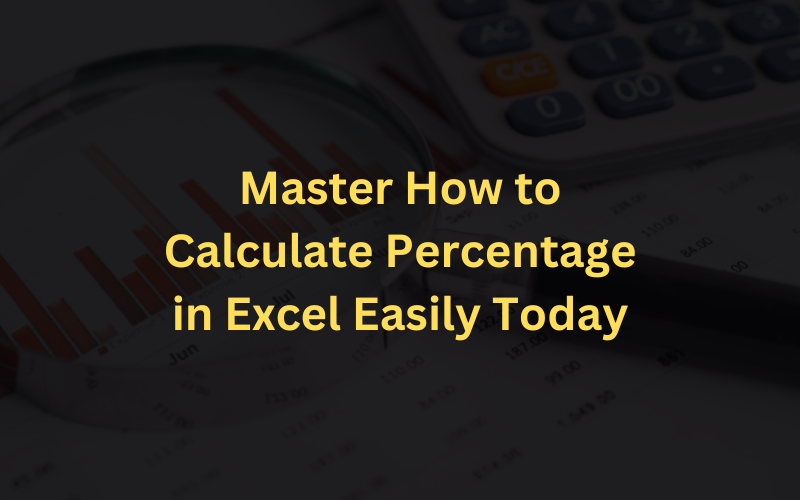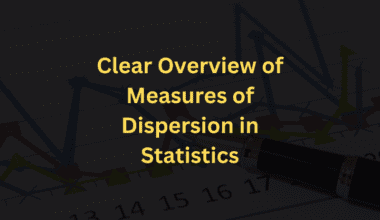Summary: Learn how to calculate percentage in Excel with step-by-step examples, formulas, and tips. From basic math to advanced tricks, this guide simplifies Excel usage for beginners and aspiring data professionals looking to sharpen their analytical edge.
Introduction
Ever found yourself wondering how to calculate a percentage in Excel without pulling your hair out? You’re not alone! With over 1.1 billion people using Microsoft’s Productivity Services—including Excel—it’s safe to say the world is hooked.
In fact, Excel holds a 7.71% share of the productivity market, and most Office users spend over a third of their time on it. That’s wild, right? This blog is your quick guide to mastering percentages in Excel without needing to be a math wizard.
You’ll learn the what, the how, and even the “ooh, I didn’t know that!” tricks—all in plain English. Let’s crunch those numbers!
Key Takeaways
- Use =Part/Whole and format the cell to display results as percentages in Excel.
- Apply formulas like =A1*20% or =A1*(1+0.2) to modify values by percentages.
- Use absolute references like $B$2 to fix cells while copying formulas across rows.
- Excel functions like IF, SUM, AVERAGE, and PERCENTRANK enhance automated percentage calculations.
- Knowing how to calculate percentage in Excel is essential for data analysis, financial planning, and data science.
What is a Percentage?
A percentage is a way to express a number as a part of 100. For example, 50% means 50 out of 100. It helps us understand proportions easily and is commonly used daily to track expenses, discounts, or test scores.
Everyday Use of Percentages
Percentages help compare values. You can use them to see how much your sales grew, calculate a product discount, or check what portion of your budget is spent. They make numbers more meaningful and easy to compare.
How Excel Makes It Simple
Excel provides simple tools to calculate percentages. The basic formula is:
(Part / Whole) * 100
You can write this in Excel as =A1/B1*100, where A1 is the part and B1 is the whole. You can also use Excel’s built-in percentage formatting to display results quickly. These features save time and make your data easier to read.
Step-by-Step Guide to Calculating Percentages in Excel
Calculating percentages in Excel may sound tricky, but it’s actually very simple. You can easily get the desired results once you know the formula and a few steps. Let’s look at three beginner-friendly examples that explain how to calculate percentages differently.
Example 1: Calculate Percentage of Marks
Suppose you have a table with students’ scores. Column B has the total marks, and Column C has the marks obtained. You want to find the percentage of marks in Column D.
- Step 1: In cell D2, type the formula: =C2/B2
This divides the marks obtained by the total marks. - Step 2: Select the cell, then click on the Percent Style button from the Home tab in the toolbar, or press CTRL+SHIFT+%.
Now, your answer will appear as a percentage instead of a decimal.
Example 2: Find a Percentage of a Number
Let’s say you want to calculate 20% of 200.
- Step 1: In any cell, type the formula: =20% * 200
- Step 2: Press Enter. Excel will display the result: 40
Example 3: Use Cell References to Calculate Percentages
If A2 contains an employee’s salary and you want to calculate 12% as their PF contribution:
- Step 1: In cell B2, enter: =A2 * 12%
- Step 2: Press Enter to see the PF amount instantly.
These easy steps will help you confidently work with percentages in Excel!
Setting Up Automatic Percentage Calculations in Excel
Excel makes it easy to calculate percentages without doing math manually. You can set up formulas once, and Excel will handle the rest automatically.
Using Formulas like IF, SUM, and AVERAGE
Excel has many useful functions that help with automatic calculations.
For example, you can use the SUM function to add numbers quickly. Suppose a student scored marks in three subjects stored in cells B2, C2, and D2. To calculate the total marks, you can use the formula:
You can also use the AVERAGE function to find the average of marks:
The IF function helps make decisions. For example:
Example: Automatically Calculating Student Marks Percentage
Step 1: Calculate Total Marks
If a student’s marks are in B2, C2, and D2, use:
Place this formula in E2 to show the total marks.
Step 2: Calculate the Percentage
Assuming F2 contains the total maximum marks (say, 300):
This will give you the percentage in decimal form.
Step 3: Format as Percentage
Select the cell with the formula → Go to Home tab → Click % symbol.
Now the result will appear as a percentage, like 87%.
Creating Templates with Pre-Set Formulas
Once you set up these formulas, you can create a reusable template. Just enter new data, and Excel will auto-calculate everything. No need to repeat the steps every time.
Tips for Using Absolute and Relative References
- Use relative references (like A2, B2) when formulas need to change for each row.
- Use absolute references (like $A$2) when referring to a fixed value, such as total marks.
These small tricks help Excel calculate everything correctly, even when you copy formulas across rows or columns.
Exploring Advanced Percentage Functions in Excel
In this section of How to Calculate Percentage in Excel, we’ll look at some advanced ways to work with percentages. These methods help you compare numbers, track changes over time, and make sure your formulas work correctly when copied across rows or columns. Don’t worry—it’s easier than it sounds!
Below are three simple examples you can try in Excel.
Calculating Percentage Change Between Two Values
This is one of the most common percentage calculations. It tells you how much a value has increased or decreased over time.
Here’s the simple formula:
(New Value – Old Value) / Old Value × 100
Example:
If your sales went from 500 to 750, the percentage increase is:
(750 – 500) / 500 × 100 = 50%
This helps you understand growth or decline in things like sales, expenses, or website traffic.
Using PERCENTRANK, PERCENTILE, and RANK
These functions are useful when comparing a number to others in a list.
- PERCENTRANK shows the relative standing of a value in a dataset. If your test score ranks high among others, PERCENTRANK will show a value closer to 1 (or 100%).
- PERCENTILE tells you the value below which a certain percent of data falls. For example, the 90th percentile is better than 90% of other scores.
- RANK simply gives a position number to a value in a list—1st, 2nd, 3rd, and so on.
Highlighting Data Using Conditional Formatting
You can use Conditional Formatting to automatically color-code cells based on percentage values.
For example, you can:
- Highlight cells with more than 80% in green
- Use red for values below 50%
Example 1: Calculate Percentage of Total Using Absolute References
If you want to know what portion each number is of the total, use absolute references. Let’s say your values are in column B and the total is in cell B7. Use this formula in column C:
=B2/$B$7
The $ signs lock cell B7 so Excel always uses the correct total when copying the formula down. Then, format the result as a percentage.
Example 2: Calculate Percentage Increase or Decrease
This is useful to see how much something has grown or dropped. Use the formula:
=(New – Old) / Old
For example, if you had 100 sticky notes yesterday and now you have 120:
=(120-100)/100 = 0.2 → 20%
In Excel, if column B has last month’s data and column C has this month’s, use in column D:
=(C2-B2)/B2
Format it as a percentage, and copy the formula down.
Example 3: Show Percentage Difference Between Two Numbers
To show the change between two numbers, use:
=(New – Old) / Old
For example, if row 2 has 300 and row 3 has 330:
=(330-300)/300 = 0.1 → 10%
This helps quickly spot increases or drops in data.
Modifying Values by a Specific Percentage
There are times when you want to increase or decrease a number by a certain percentage—like adding a 10% tax, giving a 20% discount, or boosting profits by 15%. Excel makes this super easy with simple formulas. You don’t need to be a math expert to get it right!
How to Increase a Value by a Percentage
To increase a number by a specific percentage, you can use this easy formula in Excel:
Example:
If the value is in cell A1 and you want to increase it by 50%, use this formula:
This will give you a new value that is 50% more than the original.
How to Decrease a Value by a Percentage
If you want to reduce a number by a certain percentage, the formula is just as simple:
Example:
To decrease the value in A1 by 50%, use:
This gives you the reduced amount.
When Using Cell References
You can also use other cells for flexible inputs. If A2 has the value and B2 has the percentage, write in C2:
- To increase:
- To decrease:
Tip: Enter the percentage as 50% or 0.5 in B2 so Excel understands it correctly.
With these simple steps, you can easily adjust any number by a percentage in Excel!
In a Nutshell
Mastering how to calculate percentages in Excel is a powerful skill for both everyday use and professional growth. Excel makes percentage calculations easy and efficient, from analysing sales growth to adjusting financial data.
For aspiring data scientists, understanding these Excel basics is the first step toward more advanced analytics. Excel is widely used in data wrangling and feature engineering tasks, making it essential in the data science world.
To improve your skills, join industry-recognized data science courses by Pickl.AI. Learn to apply Excel, Python, machine learning, and more—turn your number-crunching skills into a data-driven career.
Frequently Asked Questions
What is the easiest way to calculate percentage in Excel?
The simplest way is to use the formula =Part/Whole and format the cell as a percentage. For example, if C2 is the part and B2 is the whole, enter =C2/B2 in another cell and apply percentage formatting for clear, readable results.
How do I increase a value by a percentage in Excel?
Use the formula =Value*(1+Percentage). For example, to increase A1 by 20%, write =A1*1.2. This method helps when adjusting prices, taxes, or profits in Excel, especially during budgeting or financial planning tasks.
Can I calculate percentage change between two numbers in Excel?
Yes! Use the formula =(New-Old)/Old. For instance, to find sales growth from B2 to C2, type =(C2-B2)/B2 in another cell. Format it as a percentage to instantly see the increase or decrease between the two numbers.




